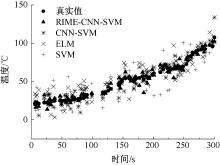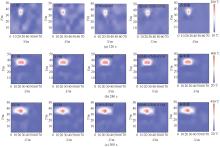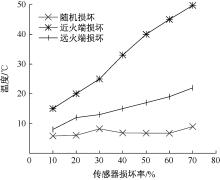| [1] |
吴楠, 杨锐, 张辉. 建筑火灾火源参数估计方法综述[J]. 灾害学, 2014, 29(3):162-167.
|
|
WU Nan, YANG Rui, ZHANG Hui. A review of methods for estimating fire source parameters in building fires[J]. Disaster Science, 2014, 29(3):162-167.
|
| [2] |
陈志昂. 商业综合体火灾灭火救援技术探索与思考[J]. 消防科学与技术, 2024, 43(6):872-876.
|
|
CHEN Zhiang. Exploration and thinking on fire extinguishing and rescue technology of commercial complex fire[J]. Fire Science and Technology, 2024, 43(6):872-876.
|
| [3] |
GUO Xin, YANG Dong, JIANG Li, et al. Full-field temperature prediction in tunnel fires using limited monitored ceiling flow temperature data with transformer-based deep learning models[J]. Fire Safety Journal, 2024, 148: DOI: 10.1016/J.FIRESAF.2024.104232.
|
| [4] |
ZHANG Yanqi, WANG Junhui, WANG Yi, et al. Intelligent planning of fire evacuation routes in buildings based on improved adaptive ant colony algorithm[J]. Computers & Industrial Engineering, 2024, 194: DOI: 10.1016/J.CIE.2024.110335.
|
| [5] |
ÖZYURT O. Efficient detection of different fire scenarios or nuisance incidents using deep learning methods[J]. Journal of Building Engineering, 2024, 94: DOI: 10.1016/J.JOBE.2024.109898.
|
| [6] |
ZHU Hui, JI Jun, NIE Jingkai. Early fire evolution and alarm characteristics of cable fires in long and narrow spaces[J]. Fire Safety Journal, 2022, 131: DOI: 10.1016/J.FIRESAF.2022.103627.
|
| [7] |
GRAGNANIELLO D, GRECO A, SANSONE C, et al. Fire and smoke detection from videos: a literature review under a novel taxonomy[J]. Expert Systems With Applications, 2024, 255: DOI: 10.1016/J.ESWA.2024.124783.
|
| [8] |
HUANG Linda, LIU Gang, WANG Yan, et al. Fire detection in video surveillances using convolutional neural networks and wavelet transform[J]. Engineering Applications of Artificial Intelligence, 2022, 110: DOI: 10.1016/J.ENGAPPAI.2022.104737.
|
| [9] |
马庆禄, 孙枭, 唐小垚, 等. 基于改进YOLOv5s算法的隧道初期火灾检测模型[J]. 中国安全科学学报, 2023, 33(10):214-223.
doi: 10.16265/j.cnki.issn1003-3033.2023.10.2424
|
|
MA Qinglu, SUN Xiao, TANG Xiaoyao, et al. Tunnel initial fire detection model based on improved YOLOv5s algorithm[J]. China Safety Science Journal, 2023, 33(10):214-223.
doi: 10.16265/j.cnki.issn1003-3033.2023.10.2424
|
| [10] |
张术琳, 张亚楠, 田超, 等. 基于CNN的化工园区火灾火焰图像识别研究[J]. 中国安全科学学报, 2024, 34(1):179-186.
doi: 10.16265/j.cnki.issn1003-3033.2024.01.2333
|
|
ZHANG Shulin, ZHANG Ya'nan, TIAN Chao, et al. CNN-based image recognition of fire flame in chemical park[J]. China Safety Science Journal, 2024, 34(1):179-186.
doi: 10.16265/j.cnki.issn1003-3033.2024.01.2333
|
| [11] |
LI Xiaojuan, WANG Chen, KASSEM M A, et al. Emergency evacuation of urban underground commercial street based on BIM approach[J]. Ain Shams Engineering Journal, 2024, 15(4): DOI: 10.1016/J.ASEJ.2024.102633.
|
| [12] |
JI Wei, LI Guoqiang, ZHU Shaojun, et al. Machine learning-driven real-time identification of large-space building fires and forecast of temperature development[J]. Expert Systems With Applications, 2024, 255: DOI: 10.1016/J.ESWA.2024.124758.
|
| [13] |
SUN Bin, GUO Tong. Gaussian model and multi-artificial fish swarm fusion algorithm for the utility tunnel fire source localization[J]. Thermal Science and Engineering Progress, 2024, 53: DOI: 10.1016/J.TSEP.2024.102739.
|
| [14] |
ZHANG Shuo, GURUSAMY S, JAMES-CHAKRABORTY K, et al. Short-term office temperature forecasting through a data-driven approach integrated with bidirectional gated recurrent neural network[J]. Energy and Buildings, 2024, 314: DOI: 10.1016/J.ENBUILD.2024.114231.
|
| [15] |
LIU Gang, MENG Hongrong, QU Guanhua, et al. Real-time monitoring and prediction method of commercial building fire temperature field based on distributed optical fiber sensor temperature measurement system[J]. Journal of Building Engineering, 2023, 70: DOI: 10.1016/J.JOBE.2023.106403.
|
| [16] |
ZHANG Tianhang, WANG Zilong, ZENG Yanfu, et al. Building artificial-intelligence digital fire (AID-Fire) system: a real-scale demonstration[J]. Journal of Building Engineering, 2022, 62: DOI: 10.1016/J.JOBE.2022.105363.
|
| [17] |
郭震, 贾笑岩, 李富民, 等. 基于机器学习的建筑火灾蔓延快速预测[J]. 中国安全科学学报, 2023, 33(11):117-125.
doi: 10.16265/j.cnki.issn1003-3033.2023.11.2219
|
|
GUO Zhen, JIA Xiaoyan, LI Fumin, et al. Fast prediction for building fire spread based on machine learning[J]. China Safety Science Journal, 2023, 33(11):117-125.
doi: 10.16265/j.cnki.issn1003-3033.2023.11.2219
|
| [18] |
牛坤, 徐大军, 张晋, 等. 综合管廊电缆火灾的试验和数值模拟研究[J]. 工业安全与环保, 2024, 50(7):1-5.
|
|
NIU Kun, XU Dajun, ZHANG Jin, et al. Experimental and numerical simulation study on cable fire in comprehensive pipe gallery[J]. Industrial Safety and Environmental Protection, 2024, 50(7): 1-5.
|
| [19] |
|
| [20] |
SU Hang, ZHAO Dong, HEIDARI A A, et al. RIME: a physics-based optimization[J]. Neurocomputing, 2023, 532: 183-214.
|













